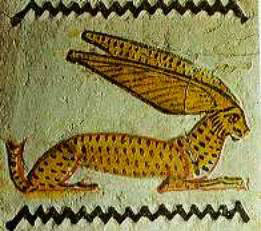With rabbits and eggs abounding everywhere at this time of the Spring Equinox, I thought it a good idea to talk about a very ancient Hare Goddess, long before the Easter Bunny and older than the Saxon Goddess Eostre. Her name is Wenet, or occasionally Unut. She is shown sometimes as a hare, sometimes as a woman with a human head and a hare on top or a woman with the head of a hare. On rare occasions she is also associated with the serpent (another Spring Equinox sacred animal) with the head of a hare.
Wenet was known as ‘the Swift One’, from vni meaning to hasten but also related to wnn meaning to be or to exist – the very essence of life. Wnn is an epithet of the God Osiris as wnn-nfr, meaning ‘He who exists in wellbeing’ Wenet’s male counterpart is also named the same as an epithet of Osiris, being Un Nefer, meaning beautiful renewal, so Osiris is her male companion.
Wenet is associated with Hermopolis or Khemenu, the centre of the worship of the God Thoth, God of writing, science and magic, who is also connected with the dead and she is a Goddess of the Underworld, taking part in the judgement of the heart.
Whilst Khemenu is associated with Thoth, the district of Khemenu was known as the Nome of Wenet, thus she was the Goddess of the 15th nome or district of Egypt. Here she was depicted as a woman with the hare sign over her head, with the head of a hare or sometimes as a lioness headed woman wearing the crown of Hathor. She also appears in lioness headed form in a stela from the Ramesseum as a consort of the God Sobek.
Her connection with the God Thoth can also be seen from Spell 137A in the Book of the Dead, ‘in a chest of secrets in the Gods own writing in the house of Wenut, the lady of Hermopolis, when sailing upstream making inspections in the temples, in the fields and in the mounds of the gods.
Spell 149 describes the mound of Wenut through which the soul travels to be reborn; O Mound of Weent, I am the greatest of the spirits who are in you. I am among the Imperishable Stars who are in you and I will not perish, nor will my name perish’.
In the Coffin Texts, Spell 47 writes; ‘I am released in company with Wenut’ and in spell 720, also from Coffin Texts, ‘I extend my arm in company with Shu, I am released in company with Wenut’. In spell 720, the deceased writes; ‘ …will act as one who is sent of the Gods and my voice is that of Wenut’.
Sometimes Wenet is seen with knives, which I often humourously recall when I see the medieval fad for painting killer rabbits taking revenge on hunters! The Tebtunis Mythological Manual in relating the myth of of the Nome of Wenet, speaks of Wenet as the ‘Lady of Fighting’. The Manual also refers to her ‘Wenut who grabbed her spear’ and ‘made a slaughter of the arrogant sun’ for which a festival was created for her and people would sing for her Ka, her soul.
As well as being venerated for her swiftness and keen senses, she is also associated with fertility as most of her kin around the world are due to their prolific breeding.
And so when you pass by all those sweet little easter bunnies, do not be deceived , their true spirit rises with the Spring Equinox….

